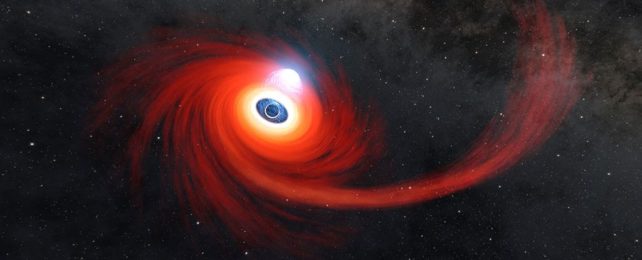Back in March of 2021, a star in a galaxy 250 million light-years away was seen having a terrible, horrible, no good, very bad day indeed.
There it was, minding its own business, when it got sucked into the gravity well of a supermassive black hole, and torn to smithereens. We know this because multiple telescopes caught sight of it from Earth, as light from the event blazed out across the Universe.
It's the fifth-closest such event – known as a tidal disruption event – ever captured, and the wealth of data obtained could help scientists better understand how black holes 'feed'.
"Tidal disruption events are a sort of cosmic laboratory," says astronomer Suvi Gezari of the Space Telescope Science Institute. "They're our window into the real-time feeding of a massive black hole lurking in the center of a galaxy."
Tidal disruption events are fairly rare, but we've seen enough of them to have a fairly detailed understanding of what happens when a star veers just a little too close to a black hole. Once the star is caught in the black hole's gravitational field, tidal forces stretch and pull it to the point that it comes apart (that's the "disruption" part).
The guts of the dismembered star then stream around the black hole in a chaotic fashion, colliding with itself and generating shocks that glow in multiple wavelengths. This process isn't instantaneous, but can take weeks or months and as the black hole devours the stellar debris.
The debris forms an orbiting disk around the black hole, falling (or "accreting") onto it from the inner rim. As material falls onto the black hole, a structure called a corona can form between the inner edge of the accretion disk and the black hole's event horizon.
This is a region of scorchingly hot electrons thought to be powered by the black hole's magnetic field, which acts like a synchrotron to accelerate the electrons to such high energies that they shine brightly in X-ray wavelengths.

Then powerful jets of plasma launch from the black hole's polar regions, shooting corona material out in opposite directions, sometimes at almost the speed of light. These astrophysical jets are thought to form when material is accelerated along magnetic field lines outside the black hole's event horizon; when it reaches the poles, off it blasts.
Coronae and jets aren't observed for all tidal disruption events, but when they do occur, they are usually seen together. So when the Zwicky Transient Facility caught the bright flash of a tidal disruption event on 1 March 2021, subsequently named AT2021ehb, NASA turned its NICER X-ray observatory and its Swift Observatory (X-rays, gamma rays, and ultraviolet radiation) to observe the event's evolution in hope of catching something interesting. Later, 300 days after the Zwicky detection, the X-ray observatory NuSTAR joined the fun.
The X-ray, ultraviolet, optical, and radio light emitted from the event over a period of 430 days revealed that the culprit was a black hole clocking in at around 10 million times the mass of the Sun. So far so normal.
But, well, something was weird. No hint of jets had been detected by any of the observatories. Yet NuSTAR's observations revealed the presence of a corona. And this weird discrepancy, scientists say, is tremendously exciting.
"We've never seen a tidal disruption event with X-ray emission like this without a jet present, and that's really spectacular because it means we can potentially disentangle what causes jets and what causes coronae," says astronomer Yuhan Yao of Caltech.
"Our observations of AT2021ehb are in agreement with the idea that magnetic fields have something to do with how the corona forms, and we want to know what's causing that magnetic field to get so strong."
Targets such as AT2021ehb make excellent laboratories for studying the formation and evolution of accretion disks and coronae in real-time; and where there is one, there may be more. The researchers hope that they'll be able to find more such tidal disruption events in the future, leading to answers about the role magnetic fields play in the formation of coronae and jets.
A bad day for a star 250 million years ago ended up being a very, very good day for human astronomers.
The research has been published in The Astrophysical Journal.
